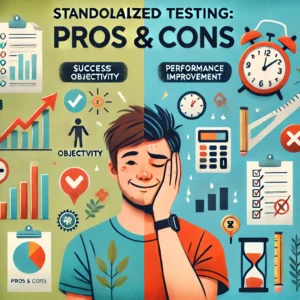Standardized testing has been a cornerstone of the education system for decades. Used in college admissions, state assessments, and policy-making, these tests aim to measure student performance and compare educational outcomes across different regions. But do standardized tests truly assess intelligence and learning ability, or are they an outdated tool that causes more harm than good? This article explores the pros and cons of standardized testing, shedding light on its impact on students, teachers, and the education system as a whole.
📌 Related Read: Pass/Fail Grading Systems: Pros and Cons
Key Statistics on Standardized Testing
| Statistic | Data |
|---|---|
| Number of students taking SAT annually | ~2.2 million |
| U.S. schools using standardized tests | 98% |
| Colleges going test-optional | 80%+ |
| Average cost of SAT prep courses | $500 – $3,000 |
What Is Standardized Testing and How Does It Work?
Standardized tests are exams designed to be administered and scored in a consistent manner. They include multiple-choice questions, essays, and problem-solving exercises, with results used for student evaluation, school funding decisions, and college admissions. Common examples include the SAT, ACT, GRE, and state-mandated assessments.
📌 Related Read: Understanding U.S. Public School Grading Scales
Comparison Table: Standardized Tests vs. Alternative Assessments
| Feature | Standardized Tests | Alternative Assessments |
|---|---|---|
| Structure | Fixed format | Flexible format |
| Scoring | Objective | Subjective |
| Feedback | Numeric scores | Qualitative feedback |
| Application | College admissions, school rankings | Performance-based learning, project assessments |
Pros of Standardized Testing
1. Provides an Objective Measure of Student Performance
✅ Standardized tests offer a fair benchmark to compare students across different schools, districts, and even countries. They help policymakers and educators make informed decisions about curriculum effectiveness and school performance.
📊 Data Insight: Countries with high standardized test scores, like Finland and Singapore, often rank higher in global education rankings.
📌 Related Read: Best U.S. High Schools
2. Identifies Strengths and Weaknesses in Learning
🔍 These tests highlight areas where students excel and where they need improvement. Schools use test results to adjust teaching strategies and allocate resources effectively.
📌 Example: A school noticing low math scores may implement extra tutoring programs.
3. A Key Factor in College Admissions
🏛️ Many universities use SAT and ACT scores as part of their admissions criteria, helping institutions evaluate applicants from diverse educational backgrounds.
Cons of Standardized Testing
1. Encourages ‘Teaching to the Test’
📚 Teachers often focus on test-related content instead of fostering critical thinking and creativity. This limits students’ ability to apply knowledge in real-world situations.
🎓 Alternative Approach: Project-based learning allows students to demonstrate skills beyond multiple-choice answers.
2. Increases Stress and Anxiety Among Students
😰 High-stakes testing creates immense pressure, leading to stress, test anxiety, and even burnout among students.
💬 Student Perspective: “I studied for months, but my anxiety on test day ruined my performance.”
📌 Related Read: Improving Your GPA: Tips for High School and College
3. Socioeconomic Disadvantages and Inequality
💰 Students from wealthier families often have access to better test preparation resources, creating an unfair advantage over lower-income students.
Are Standardized Tests Good or Bad? (Balancing the Debate)
While standardized testing provides measurable data, it has significant drawbacks. Many educators advocate for a blended approach, combining standardized tests with alternative assessment methods to provide a more comprehensive evaluation of student learning.
📌 Alternative Assessment Examples:
| Method | Benefits |
|---|---|
| Portfolio Assessments | Showcases student work over time |
| Performance-Based Tests | Measures practical application of knowledge |
| Teacher Evaluations | Personalized feedback on student progress |
The Future of Standardized Testing
With technological advancements, AI-driven adaptive testing and performance-based assessments are emerging as alternatives. Many colleges are adopting test-optional policies, shifting towards holistic admissions processes.
📉 Trend Alert: Over 80% of U.S. colleges are now test-optional or test-flexible.
Conclusion
Standardized testing has its merits and flaws. While it offers a uniform method of assessment, it also creates stress and disadvantages for certain students. As the education system evolves, it is crucial to explore fairer and more effective ways to evaluate student performance.
Disclosure: This post contains affiliate links. If you click and make a purchase, we may earn a small commission at no extra cost to you.
If your teen is getting ready for college admissions, the Barron’s SAT Study Guide Premium 2025 is a must-have resource to help them feel confident and prepared.
Frequently Asked Questions (FAQ)
Why should we get rid of standardized testing?
We should consider getting rid of standardized testing because it often creates unnecessary stress for students and teachers, and it only measures a narrow range of skills like math and reading. It also pushes schools to “teach to the test,” limiting creativity and critical thinking. Actionable Tip: Schools could replace standardized tests with project-based assessments, where students solve real-world problems and demonstrate broader skill sets.
What are the arguments for standardized testing?
Supporters of standardized testing argue that it provides an objective, fair way to measure student performance across the board. It holds schools accountable for their results and ensures all students are evaluated by the same standards. Unique Insight: One overlooked benefit is that standardized tests can help identify trends in education, showing where schools need more support.
Are standardized tests actually useful?
Standardized tests are useful in providing a snapshot of student performance and comparing results across different regions. However, they are only part of the puzzle. Actionable Tip: Use standardized test results in combination with other assessments like projects and portfolios to get a fuller picture of a student’s abilities.
What would be better than standardized testing?
A better alternative to standardized testing could be portfolio assessments, where students compile their work over time, or project-based learning that focuses on solving real-world problems. These methods highlight growth, creativity, and problem-solving skills, which tests often miss. Actionable Tip: Encourage schools to experiment with mixed evaluation methods to cater to different learning styles.
What is the biggest issue with standardized testing?
The biggest issue with standardized testing is that it emphasizes memorization over critical thinking and creativity. It also disadvantages students from low-income families who may not have access to the same resources or test preparation. Unique Insight: Offering more test preparation in underserved areas could level the playing field for disadvantaged students.
What are the three main purposes of standardized testing?
Assess student performance: To gauge how well students understand specific academic subjects.
Compare results across regions: To track and compare the performance of schools, districts, and even states.
Hold schools accountable: To ensure schools meet certain educational standards.
Unique Insight: Standardized testing should evolve to also assess skills like problem-solving and collaboration, which are crucial for modern careers.
Why do people agree with standardized testing?
People agree with standardized testing because it provides a structured, reliable way to measure academic progress. It ensures that schools are held accountable and gives parents a way to track how their child is doing compared to peers. Actionable Tip: To improve its fairness, policymakers could pair standardized tests with other forms of assessment to create a more holistic evaluation system.
What are the benefits of standardized testing?
Standardized tests provide an objective way to measure student performance and identify academic strengths and weaknesses.
Do standardized tests affect student performance?
Yes, standardized tests influence teaching strategies and school funding but can also cause stress and anxiety in students.
Why do students fail standardized tests?
Factors include lack of preparation, test anxiety, socioeconomic disadvantages, and limitations in the test format.
What are the negative effects of standardized testing?
Standardized testing can lead to high stress, teaching to the test, and educational inequality.

Nawab, an educator with a decade of K-12 teaching, holds a graduate degree and a diploma in elementary education. He has also been blogging for five years, sharing insights for educators and parents.


5 thoughts on “Pros and Cons of Standardized Testing: Is It Helping or Hurting Students?”